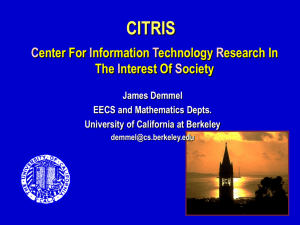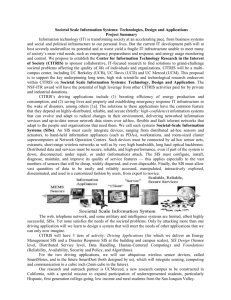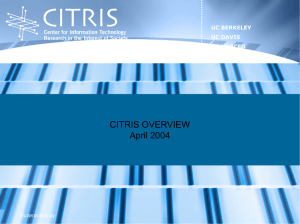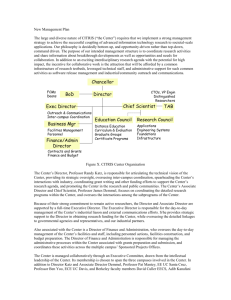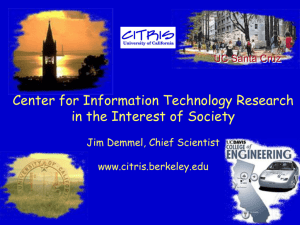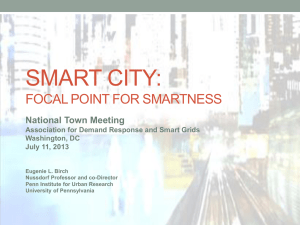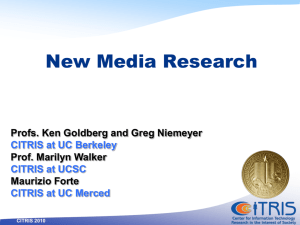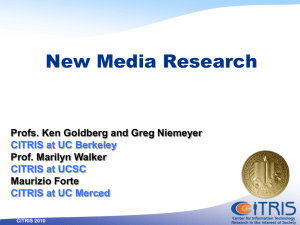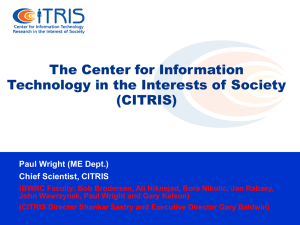in PowerPoint - Computer Science Division
advertisement
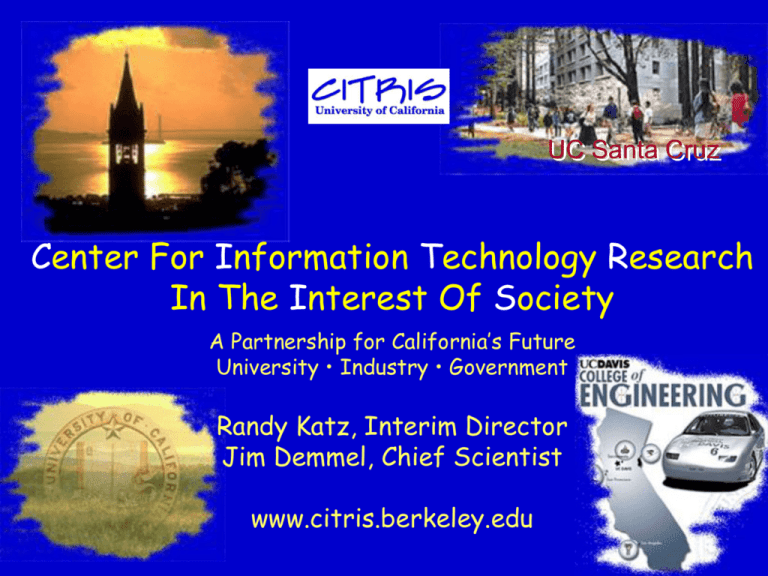
UC Santa Cruz Center For Information Technology Research In The Interest Of Society A Partnership for California’s Future University • Industry • Government Randy Katz, Interim Director Jim Demmel, Chief Scientist www.citris.berkeley.edu Center For Information Technology Research In The Interest Of Society “Never doubt that a small group of thoughtful committed citizens can change the world. Indeed, it is the only thing that ever has.” –Margaret Mead Major new initiative within the College of Engineering and on the Berkeley Campus Joint with UC Davis, UC Merced, UC Santa Cruz, LBNL, LLNL Over 90 faculty from 21 departments Many industrial partners Significant State and private support CITRIS will focus on IT solutions to tough, quality-of-life related problems CITRIS Scientific Strategy Societal-ScaleApplications Applications Societal-Scale Societal-Scale Applications Applications Pull Beyond desktop Huge scale Can’t fail New Distributed System Architectures Scalable, Utility, Diverse Access Always connected Technology Push Distributed intelligence Smart displays, cameras, sensors Technological Breakthroughs The CITRIS Model Core • Distributed Info Systems Technologies Applications • Quality-of-Life Emphasis • Initially Leverage Existing Expertise on campuses • Micro sensors/actuators • Human-Comp Interaction • Prototype Deployment Societal-Scale Information Systems (SIS) Foundations • Security, Policy • Probabilistic Systems • Formal Techniques • Data management • Simulation • Energy Efficiency •Transportation Systems • Natural Disaster Mitigation • Environmental Monitoring • Distributed education • Distributed biomonitoring Fundamental Underlying Science Initial CITRIS Applications (1) Saving Energy Smart Buildings that adjust to inhabitants Make energy deregulation work via real-time metering and pricing Large potential savings in energy costs: for US commercial buildings Turning down heat, lights saves up to $55B/year, 35M tons C emission/year 30% of $45B/year energy bill is from “broken systems” Transportation Systems Use SISs to improve the efficiency and utility of highways while reducing pollution Improve carpooling efficiency using advanced scheduling Improve freeway utilization by managing traffic flows Large potential savings in commuter time, lost wages, fuel, pollution: for CA 15 minutes/commuter/day => $15B/year in wages $600M/year in trucking costs, 150K gallons of fuel/day Natural Disaster Mitigation $100B-$200B loss in “Big One”, 5K to 10K deaths Monitor buildings, bridges, lifeline systems to assess damage after earthquake Provide efficient, personalized responses Must function at maximum performance under very difficult circumstances Initial CITRIS Applications (2) Distributed Biomonitoring Wristband biomonitors for chronic illness and the elderly Monitored remotely 24x7x365 Emergency response and potential remote drug delivery Cardiac Arrest Raise out-of-hospital survival rate from 6% to 20% => save 60K lives/year Distributed Education Smart Classrooms Lifelong Learning Center for professional education Develop electronic versions of UC Merced’s undergraduate CS curriculum Environmental Monitoring Monitor air quality near highways to meet Federal guidelines Mutual impact of urban and agricultural areas Monitor water shed response to climate events and land use changes Societal-Scale Systems New System Architectures New Enabled Applications Diverse, Connected, Physical, Virtual, Fluid “Server” “Client” Information Appliances MEMS Sensors Massive Cluster Gigabit Ethernet Clusters Scalable, Reliable, Secure Services Societal-Scale Information System (SIS) Information Utility – Planetary-scale/non-stop; secure, reliable, highperformance access, even when overloaded, down, disconnected, under repair, under attack Smart System – Learns usage/adapts functions & interfaces Managing Diversity – Component plug-and-play; integrate sensors / actuators, hand-held appliances, workstations, building-sized cluster supercomputers Always Connected – Short-range wireless nets to high-bandwidth, highlatency long-haul optical backbones Implementation & Deployment of an Oceanic Data Information Utility (Professor John Kubiatowicz, et. al) Ubiquitous devices require ubiquitous storage Consumers of data move, change access devices, work in many different physical places, etc. Needed properties: Canadian OceanStore Sprint AT&T Strong Security Coherence Automatic replica management and Pac IBM Bell optimization Simple and automatic recovery from disasters Utility model Confederations of (Mutually Suspicious) Utilities IBM Smart Dust MEMS-Scale Sensors/Actuators/Communicators Create a dynamic, ad-hoc network of power-aware sensors Explore system design issues Provide a platform to test Dust components Use off the shelf components initially Micro Flying Insect ONR MURI/ DARPA funded Year 2 of 5 year project Professors Dickinson, Fearing (PI), Liepmann, Majumdar, Pister, Sands, Sastry Synthetic Insects (Smart Dust with Legs) Goal: Make silicon walk. •Autonomous •Articulated •Size ~ 1-10 mm •Speed ~ 1mm/s Prototype Dust Mote PicoRadio Extending the Scope and … Pushing the Envelope Wireless node Offices Entrance Exhibits Cafe Experimental Testbeds Soda Hall IBM WorkPad Velo Nino Smart Dust LCD Displays MC-16 Motorola Pagewriter 2000 CF788 Smart Classrooms Audio/Video Capture Rooms Pervasive Computing Lab CoLab WLAN / Bluetooth Wearable Displays GSM BTS Pager H.323 GW Network Infrastructure TCI @Home Adaptive Broadband LMDS Millennium Cluster Millennium Cluster CalRen/Internet2/NGI Foundational Research Problems How do we make SISs reliable? Henzinger, Aiken Necula, Sastry, Wagner Complexity => hybrid modeling Multi-aspect interfaces to reason about properties Software quality => combined static/dynamic analysis How do we make SISs available? Patterson, Yelick Repair-Centric Design Availability modeling and benchmarking Performance fault adaptation How do we make SISs secure? Tygar, Wagner, Samuelson Lightweight authentication and digital signatures Graceful degradation after intrusion Protecting privacy, impact of related legislation California Institutes in Science and Technology Governor Gray Davis’ Initiative $100M state funding for capital projects over 4 years--matched 2:1 by Federal, industrial, private support Focus on “hot” areas for 21st Century, limited to UC campuses Three initially funded: UCSF/UCB/UCSC (Bioinformatics) UCLA/UCSB (Nanotechnology) UCSD/UCI (Information Technology) UCB-led CITRIS proposal in 2001-2002 State budget Committed Support from Industry Founding Corporate Members of CITRIS We have received written pledges to CITRIS of over $170 million from individuals and corporations committed to the CITRIS longrange vision CITRIS Institute Proposal CITRIS Leadership Interim Director - Randy Katz Associate Director and Chief Scientist - James Demmel Research Coordination Council Adib Kanafani - Applications David Culler - Societal Scale Information Systems Dave Patterson - Foundations Ben Yoo - Research Infrastructure Pamela Samuelson - Public Policy Manuel Castells, Annalee Saxenian - Social Impacts Education Coordination Council - Paul Wright chairs Government and Industrial Outreach – Tom Kalil Other Campuses Ben Yoo – UC Davis Pat Mantey – UC Santa Cruz David Ashley – UC Merced Executive Director TBD CITRIS-Affiliated Research Activities International Computer Science Institute,(5 faculty, 18 students) studies network protocols and applications and speech and language-based humancentered computing. Millennium Project (15 faculty) is developing a powerful, networked computational test bed of nearly 1,000 computers across campus to enable interdisciplinary research. Berkeley Sensor and Actuator Center BSAC (14 faculty, 100 students) is a world-leading effort specializing in micro-electromechanical devices (MEMS), micro-fluidic devices, and “smart dust.” Microfabrication Laboratory (71 faculty, 254 students) is a campus-wide resource offering sophisticated processes for fabricating micro-devices and micro-systems. Gigascale Silicon Research Center (23 faculty, 60 students) addresses problems in designing and testing complex, single-chip embedded systems using deep sub-micron technology. Berkeley Wireless Research Center (16 faculty, 114 students) is a consortium of companies and DARPA programs to support research in low-power wireless devices. Applications-Related Current Activities Partners for Advanced Transit and Highways, PATH, (20 faculty, 70 students), a collaboration between UC, Caltrans, other universities, and industry to develop technology to improve transportation in California. Berkeley Seismological Laboratory (15 faculty, 14 students) operates, collects, and studies data from a regional seismological monitoring system, providing earthquake information to state and local governments. Pacific Earthquake Engineering Research Center, PEER ( 25 faculty, 15 students), a Berkeley-led NSF center, is a consortium of nine universities (including five UC campuses) working with industry and government to identify and reduce earthquake risks to safety and to the economy. National Center of Excellence in Aviation Operations Research, NEXTOR (6 faculty, 12 students), a multi-campus center, models and analyzes complex airport and air traffic systems. Human-Centered Systems: Adapting technology to people, not people to technology (faculty from EECS, Psychology, Sociology, Education, SIMS, ME, Business) Bioengineering Research Center - QB3 Lawrence Berkeley National Laboratory (NERSC, EET, …) The Inelasticity of California’s Electrical Supply 800 700 $/MWh 600 500 400 300 200 100 0 20000 25000 30000 35000 40000 45000 MW Power-exchange market price for electricity versus load (California, Summer 2000) How to Address the Inelasticity of the Supply Spread demand over time (or reduce peak) Make cost of energy visible to end-user function of load curve (e.g. hourly pricing) “demand-response” approach Reduce average demand (demand side) Eliminate wasteful consumption Improve efficiency of equipment and appliances Improve efficiency of generation and distribution network (supply side) Enabled by Information! Energy Consumption in Buildings (US 1997) End Use Space heating Space cooling Water heating Refrigerator/Freezer Lighting Cooking Clothes dryers Color TVs Ventilation/Furnace fans Office equipment Miscellaneous Total Residential 6.7 1.5 2.7 1.7 1.1 0.6 0.6 0.8 0.4 3.0 19.0 (Units: quads per year = 1.05 EJ y-1) Source: Interlaboratory Working Group, 2000 Commercial 2.0 1.1 0.9 0.6 3.8 0.6 1.4 4.9 15.2 A Three-Phase Approach Phase 1: Passive Monitoring The availability of cheap, connected (wired or wireless) sensors makes it possible for the end-user to monitor energy-usage of buildings and individual appliances and act there-on. Primary feedback on usage Monitor health of the system (30% inefficiency!) Phase 2: Quasi-Active Monitoring and Control Combining the monitoring information with instantaneous feedback on the cost of usage closes the feedback loop between end-user and supplier. Phase 3: Active Energy-Management through Feedback and Control—Smart Buildings and Intelligent Appliances Adding instantaneous and distributed control functionality to the sensoring and monitoring functions increases energy efficiency and user comfort Smart Buildings Dense wireless network of sensor, control, and actuator nodes • Task/ambient conditioning systems allow conditioning in small, localized zones, to be individually controlled by building occupants and environmental conditions • Joined projects between BWRC/BSAC, School of Architecture (CBE), Civil Engineering, and IEOR with Berkeley and Santa Cruz A Proof-of-Concept: A six month demonstration, already underway! Leaders: Pister, Culler, Trent, Sastry, Rabaey “Easy”: Fully instrument a number of buildings on campus with networked light and temperature sensors in every room, and make the data available on a centralized web-site. “Medium”: Make a wireless power monitor with a standard 3-prong feedthrough receptacle so that people can monitor power consumption of electronic devices as a function of time. Similar device, but passively coupled to high-power wiring to monitor total power consumption through breaker boxes. This would give us a much finer granularity of power-consumption details, and let us look at clusters of rooms, floors, etc. Fully instrument the campus power distribution system “Hard”: Real-time monitoring and control of hundreds of power systems on campus. Enforce compliance with load reduction. Charge/reward departments according to their use during peak times. SUGAR - A tool for MEMS Cad Descendant of Spice Goal: Fast and just accurate enough for design Full FE analysis too slow Scope so far 3D electromechanical simulation steady state, modal, transient analyses Widely used 100 designers at UCB Universities, govt labs, industry www-bsac.berkeley.edu/~cfm Web service Challenges in MEMS Simulation Better Mechanical models Contact Multiscale robustness Reduced order modeling Sensitivity analysis Design Optimization Scalability Eigenmodes of a MEMS mirror MEMS Resonator A stepper motor we’d like to simulate: challenges of contact problems Challeges to using sensor data in seismic modeling and disaster response Position/motion/moisture/chemical/temperature/GPS sensors across civil infrastructure Recent NRC report Increase knowledge of safety of buildings, bridges, … Improve emergency response Forecast earthquake impacts What to do with all the data? Vast, noisy, partial Use it to drive models of structures, transport systems,… Where do we get the models? Scanning in the Golden Gate Bridge Use existing 3D laser scanner St. Peter’s Basilica (“Fiat Lux” at SIGGRAPH) Taj Mahal, Michaelangelo’s David, Sather Tower Problems Registering multiple images Noise Meshing Feature extraction (materials) Hard to reach places Automatically Generated 3D Model X-ray scans of reinforced concrete
